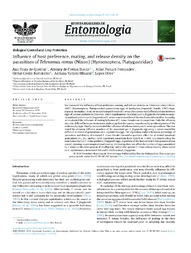Influence of host preference, mating, and release density on the parasitism of Telenomus remus (Nixon) (Hymenoptera, Platygastridae).
Influence of host preference, mating, and release density on the parasitism of Telenomus remus (Nixon) (Hymenoptera, Platygastridae).
Autoria: QUEIROZ, A. P. de; BUENO, A. de F.; POMARI-FERNANDES, A.; BORTOLOTTO, O. C.; MIKAMI, A. Y; OLIVE, L.
Resumo: We evaluated the influence of host preference, mating, and release density on Telenomus remus (Nixon, 1937) (Hymenoptera: Platygastridae) parasitizing eggs of Spodoptera frugiperda (Smith, 1797) (Lepidoptera: Noctuidae). First, we tested host preference of T. remus (free choice test) offered a choice between eggs of Corcyra cephalonica (Stainton, 1865) (Lepidoptera: Pyralidae) and S. frugiperda. Parasitism capacity and host preference (S. frugiperda) of T. remus reared on either of the two hosts did not differ. Secondly, we evaluated the influence of mating behavior of T. remus females on its parasitism. Only the offspring sex ratio differed between treatments, indicating that the species reproduces by parthenogenesis of the arrhenotoky type. Finally, we evaluated the influence of release density on T. remus parasitism. This was tested by releasing different numbers of the parasitoid per S. frugiperda egg using T. remus reared for different numbers of generations on C. cephalonica eggs. The regression analysis between percent age of parasitism and density of released T. remus females showed a quadratic effect for all tested parasitoid generations (F 35 , F 40 , and F 45 ) with maximum parasitism from 65.07% to 71.69%. Our results allow the conclusion that (a) T. remus prefers S. frugiperda eggs, regardless of the host on which this parasitoid was reared, showing no preimaginal conditioning; (b) Mating does not affect the number of eggs parasitized by T. remus or the development of its offspring; and (c) The optimal T. remus release density when reared on C. cephalonica is between 0.133 and 0.150 females/ S. frugiperda .
Ano de publicação: 2017
Tipo de publicação: Artigo de periódico
Unidade: Embrapa Soja
Palavras-chave: Entomologia
Observações
1 - Por padrão são exibidas publicações dos últimos 20 anos. Para encontrar publicações mais antigas, configure o filtro ano de publicação, colocando o ano a partir do qual você deseja encontrar publicações. O filtro está na coluna da esquerda na busca acima.
2 - Para ler algumas publicações da Embrapa (apenas as que estão em formato ePub), é necessário ter, no celular ou computador, um desses softwares gratuitos. Sistemas Android: Google Play Livros; IOS: iBooks; Windows e Linux: software Calibre.
Acesse outras publicações
Acesse a Base de Dados da Pesquisa Agropecuária (BDPA) para consultar o acervo completo das bibliotecas da Embrapa.

